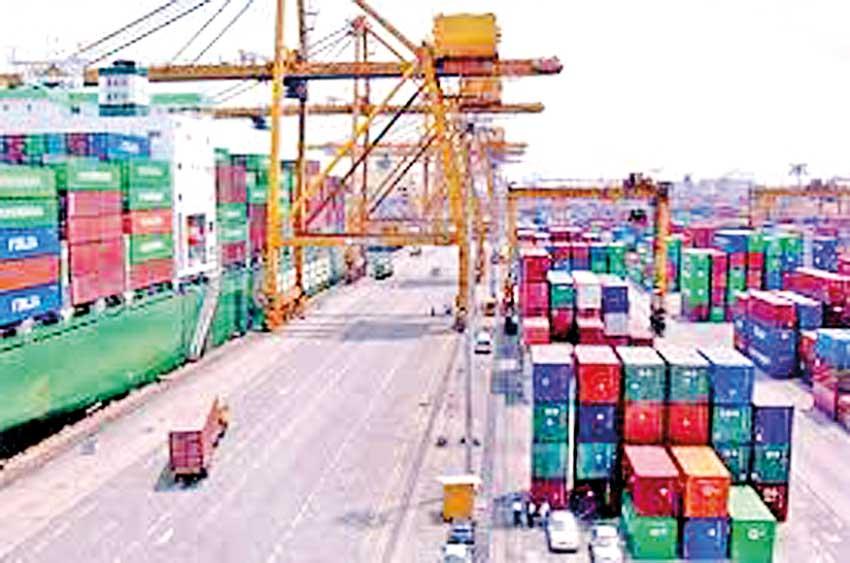Reply To:
Name - Reply Comment

Sri Lanka’s trade deficit declined for the first time in six months on a year-on-year (YoY) basis in September to US $ 495 million, from US $ 525 million a year ago, as export income continued to grow in the month while import expenditure remained static.
Despite a decline in volumes, earnings from merchandise exports grew by 3.1 percent YoY to US $ 1.03 billion in the month, surpassing the US $ 1 billion mark for the fourth consecutive month in the year.
The import expenditure remained static in the month, recording a marginal YoY growth of 0.1 percent and reaching US $ 1.526 billion in the month. This was mainly due to a decline in investment goods imports, non-importation of crude oil and volume decline in refined petroleum.
The trade deficit also declined on a month-on-month (MoM) basis in September, compared to the US $ 586 million deficit recorded in the previous month.
However, the cumulative deficit in the trade account topped US $ 6 billion in the nine months, as it grew to reach US $ 6003 million, from US $ 4,337 million a year back. This was mainly driven by a US $ 691.7 million increase in the fuel import bill, US $ 540.3 million rise in textiles and textile articles imports and a US $ 467.6 million increase in machinery and equipment imports.
In addition, a US $ 49.5 million contraction in plastics and articles export income also contributed to the widening of the trade deficit.
Terms of trade, the ratio of the price of exports to the price of imports, deteriorated by 15.6 percent in September from a year ago, as the prices of imported goods rose at a higher rate than the prices of exported goods.
In the month, industrial exports, driven by textile and garment exports, grew by 4 percent YoY to US $ 805.7 million. The textiles and garments exports rose by 5.7 percent YoY to US $ 458.5 million in the month. The export income from rubber products grew by a notable 16.6 percent YoY to reach US $ 90.9 million in the period.
Further, income from petroleum exports continued to recover in the month, due to the increase in bunker fuel exports, reflecting higher prices. The export income from petroleum products grew by 53.7 percent YoY to US $ 87.6 million in the month. Meanwhile, export earnings from agricultural goods decreased by 0.6 percent to US $ 221.2 million in the month, driven by a notable decline in tea exports. Earnings from tea exports declined by 8.7 percent YoY to US $ 104.1 million in the month, due to lower export prices, which was by 5.8 percent YoY as well as a decline in export volumes (by 3.0 percent). The industry saw shortages of fertiliser supply in the month, due to the import ban on chemical fertilisers and agrochemicals.
Further, export earnings from spices also declined by 3.4 percent YoY to US $ 37.3 million, due to the lower export volumes of cinnamon, nutmeg and mace.
Overall, the cumulative export earnings grew by 20 percent YoY to US $ 8.93 billion in the nine-month period.Meanwhile, import expenditure on the consumer goods in September rose by 16.6 percent YoY to US $ 310.7 million, led by higher expenditure on non-food consumer goods.
However, import expenditure on food and beverage imports declined by 12.4 percent YoY in the month to US $ 109.8 million, mainly due to lower imports of sugar. In contrast, import expenditure on dairy products and vegetables grew by 63.8 percent YoY and 47.9 percent YoY to US $ 39.4 million and US $ 23.9 million in the month, respectively. Import expenditure on non-food consumer goods segment increased by 42.2 percent YoY to US $ 201 million, mainly owing to the importation of vaccines, categorised under medical and pharmaceuticals.
Further, several other categories of non-food consumer goods, including telecommunication devices, clothing and accessories, rubber products (mainly tyres) and household and furniture items (mainly textile articles), also rose in the month. However, import expenditure on home appliances declined by 11.9 percent YoY to US $ 15 million in the month. Meanwhile, import expenditure on intermediate goods declined by 4 percent YoY to US $ 848.4 million in the month, due to lower imports of fuel, wheat (mainly wheat grain), mineral products (mainly cement clinkers) and fertilisers.
Expenditure on fuel imports contracted by 6.1 percent YoY to US $ 201 million in the month, due to non-importation of crude oil and low import volumes of refined petroleum, driven by the availability of sufficient stocks.
Despite lower import volumes, expenditure on refined petroleum imports (including LP gas) rose by 20.9 percent YoY to US $ 163 million in the month, as average import prices rose by 64.6 percent YoY.
Further, expenditure on coal imports rose notably, contributed by both higher import volumes and prices.
In the month, expenditure on importation of investment goods decreased by 2.1 percent YoY to US $ 366.5 million. This was mainly due to a notable 11.8 percent decline recorded in machinery, equipment parts and crane imports.
Further, import expenditure on cement also saw a contraction, due to lower import volumes.
Overall, the cumulative import expenditure during the nine-month period rose by 26.8 percent to US $ 14.94 billion, including a 25 percent YoY growth in non-fuel imports.